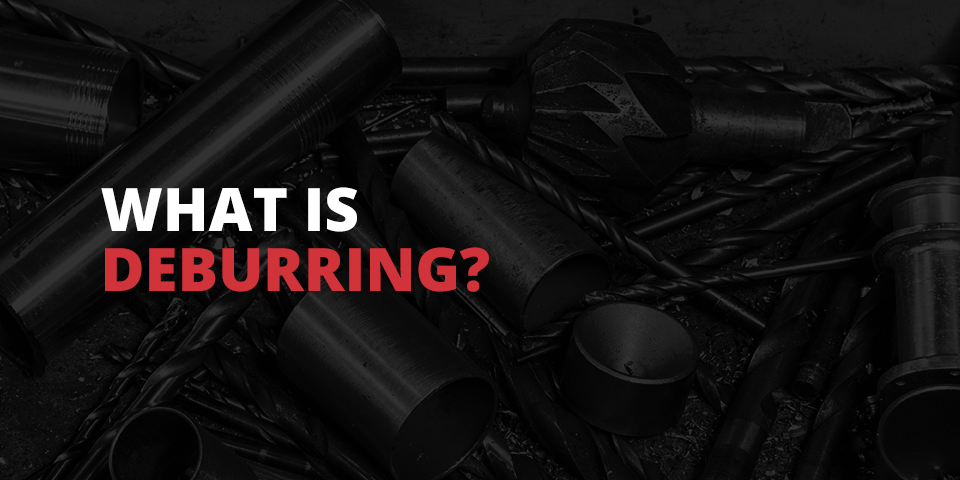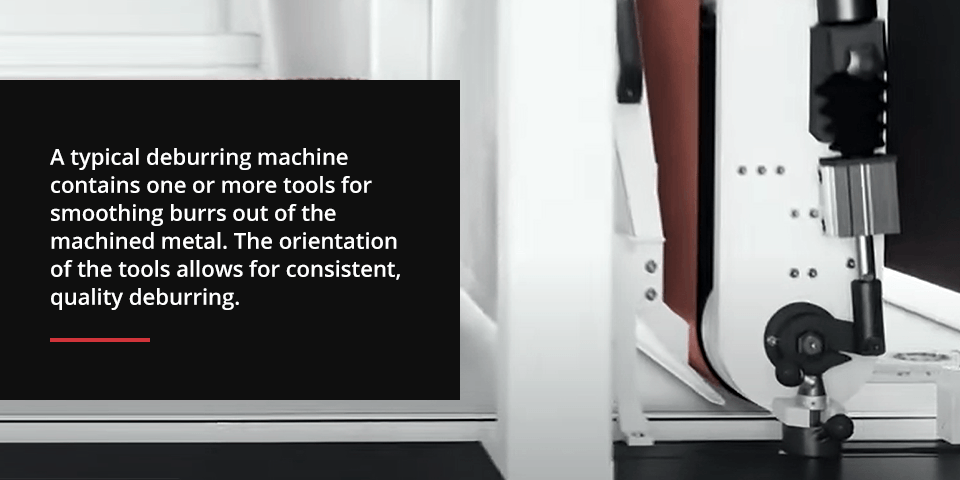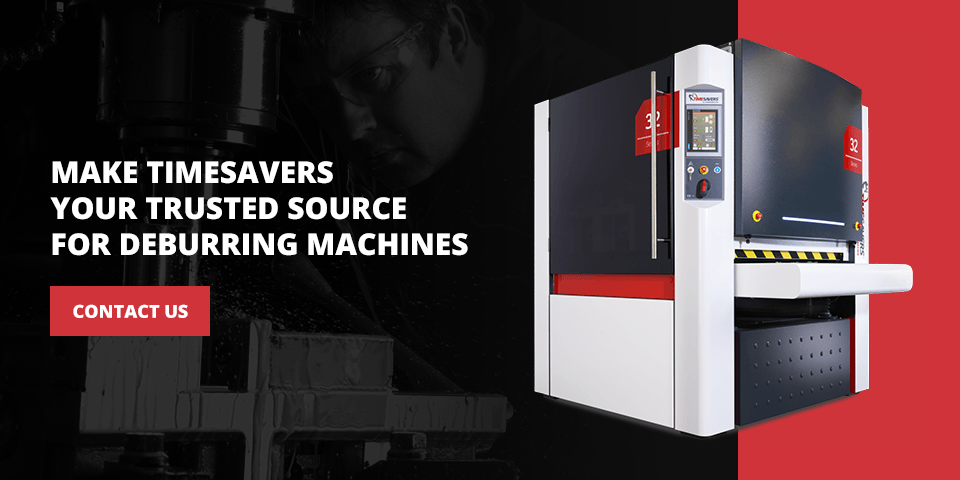What Is Deburring?

Table of Contents
- Deburring Definition
- What Causes a Burr?
- How Do You Remove Burrs From Metal?
- How Does a Deburring Machine Work?
- Why Is Deburring Necessary?
- 4 Simple Tips for Deburring Metal
- Make Timesavers Your Trusted Source for Deburring Machines
If you shop regularly for machine parts, you’ve probably had to deal with unwelcome burrs on your workpieces. These imperfections are unsightly, and they reduce the functionality and safety of each affected part. You need a reliable way to remove burrs and provide smooth, quality components.
Deburring machines offer an ideal solution. The guide below will describe what causes a burr, explain why deburring is so critical and discuss how to remove burrs from metal.
Deburring Definition
Deburring is the process of removing the small imperfections known as burrs from machined metal products.
Machining processes shape a piece of metal in different ways. Stamping, for instance, presses the workpiece in a die set, while milling uses a rotating tool to shave metal off a workpiece. Processes like these don’t always work perfectly, though — they may leave small ridges or protrusions of metal known as burrs.
Burrs compromise the quality of the finished part if they are not removed. After machining or welding, deburring removes these imperfections to provide a smooth, reliable metal part.
What Causes a Burr?
Burrs are a common occurrence during the machining process. They may appear during several different stages of machining:
- Stamping
- Forming
- Fineblanking
- Casting
- Sintering
- Molding
- Turning
- Milling
- Grinding
- Drilling
- Engraving
- Plasma cutting
- Waterjet cutting
- Laser cutting.
When burrs form, they may take one of three main types:
- Rollover burrs: Rollover burrs are the most common types of burrs. They look like tiny bits of curled metal projecting up from the workpiece.
- Poisson burrs: Poisson burrs occur when too much metal collects at the end of the workpiece and extends sideways.
- Breakout burrs: Breakout burrs have a characteristic upswelling shape that makes them look like they are breaking out of the workpiece.
How Do You Remove Burrs From Metal?
Fortunately, deburring is relatively easy with the right tools and techniques. Deburring may take a few different forms depending on the metal and application in question:
- Manual deburring: Manual deburring is the most common and labor-intensive deburring method. In manual deburring, experienced technicians scrape or buff the burrs out of the metal pieces by hand using simple tools. Though this process is easy, it is time-consuming and can dramatically reduce productivity.
- Mechanical deburring: Mechanical deburring uses a deburring machine to grind the burr off. This method is costlier but much more efficient than manual deburring, so it is a popular option in machining operations.
- Thermal deburring: Thermal deburring uses combustive gases to generate thermal energy and essentially scald the burrs out of the metal. This process is often ideal for getting out the most hard-to-reach burrs — those in cracks or crevices, for instance — or addressing burrs on multiple surfaces simultaneously.
- Electrochemical deburring: Electrochemical deburring uses a solution of salt or glycol to conduct energy through the burrs. The electrochemical energy blasts away the burrs while leaving the surrounding metal intact. This process is most useful for working with extremely challenging metals, reaching difficult areas or ensuring high precision in burr removal.

How Does a Deburring Machine Work?
What does a deburring machine do? A typical deburring machine contains one or more tools for smoothing burrs out of the machined metal. The orientation of the tools allows for consistent, quality deburring.
Many deburring machines use brushes, discs or belt heads for grinding burrs out of workpieces. Some machines use a single deburring head, whereas other more advanced machines use several:
- Brush heads: Rotating brush heads work effectively on small, delicate parts because they can remove unwanted burrs without damaging the metal or its surface coatings. They are also highly effective at edge rounding and can generally rotate through 360 degrees to reach inaccessible areas on the workpiece.
- Disc heads: Disc heads are also well suited to small, delicate parts. Their rotating pads create a distinctive pattern that helps to keep the workpiece from fracturing under stress.
- Belt heads: Belts run on continuously turning drums. They have excellent reach and can effectively remove burrs from a workpiece’s edges and sides. One downside, however, is that though they are well suited to removing vertical burrs, they can sometimes shift material to the sides of a workpiece, creating new lateral burrs.
One of the benefits of using a deburring machine is the variety of configurations it offers. In many machines, the deburring tools consist of polyamide fibers coated with rough abrasives, similar to sandpaper grains. The abrasives wear down the burrs to leave the machined metal smooth.
Different grain sizes and materials are suitable for different metal hardnesses and various applications. Some of the most commonly used grains include the following:
- Aluminum oxide
- Ceramic
- Cubic boron nitride (CBN)
- Diamond
- Silicon carbide.
Deburring machines may also be wet or dry machines. Some dust from machined materials is flammable, and a spark from grinding metal can easily ignite it. A wet deburring machine moistens the dust as it works to prevent the dust from catching fire and posing a safety hazard.
How can you choose the right machine for your applications? Your selection will depend on the nature of the parts you most often machine. The part size, type of metal, coatings like paint or cladding and desired quality of the finished piece will determine the level of deburring you need. For instance, with some parts, you can merely remove vertical burrs while leaving lateral burrs in place. For higher quality requirements — in components for aerospace or medical applications, for instance — you will need a more advanced machine that can provide sophisticated, comprehensive deburring.
Why Is Deburring Necessary?
Burrs compromise the functionality, lifespan and safety of a machined part. They can cause numerous part quality issues like these:
- Cracks and material failures
- Increased localized stress
- Decreased fracture resistance
- Failure after fewer stress cycles
- Poor fastener seating
- Fastener damage
- Increased susceptibility to corrosion
- Increased risk of static discharge
- Undesirable friction and heat
- Increased surface-to-surface wear
- Lubrication issues
- Overall diminished safety.
Deburring removes these defects to create a safer, more functional and more aesthetically appealing part. Mechanical deburring with a machine also eliminates the need for sanding and grinding by hand. It increases productivity, decreases material consumption and improves finished results.
Mechanical deburring also helps to generally enhance your finishing processes. Deburring generally takes place as part of a more comprehensive finishing process that usually includes other techniques, such as:
- Deslagging
- Edge breaking
- Graining
- Descaling before painting and further processing.
In many fabrication shops, finishing accounts for 30 to 35% of the manual labor costs, and the turnover in this area is often high. Finishing also serves as the final quality assurance checkpoint for the customer’s parts before painting or shipping. By purchasing a deburring machine, shops can decrease labor costs, ensure higher quality and increase safety by replacing a high-turnover position.
4 Simple Tips for Deburring Metal
Now that we’ve covered the essentials of metal deburring, let’s go over a few straightforward strategies you can leverage to make this process faster and safer.
1. Consider Automatic Deburring
After their machine finishes cutting a plate or other part, many metalworkers will manually deburr it while waiting for the next piece to finish. The problem with this approach is that no human can match the pace or consistency of an automated deburring system. Hand-grinding your metal parts to deburr them requires large amounts of time and effort, slowing down your production process. Deburring parts by hand also leads to different finishes for each and every product, lessening the consistency and overall quality of the components you finish. Last but not least, manual grinding can cause repetitive-motion injuries over time, making it a safety risk for metalworkers.
If you’re looking to maximize the efficiency, consistency and safety of your deburring processes, then we recommend that you consider automated deburring. Automatic deburring machines can finish metal parts substantially faster than hand grinding systems while also ensuring a smooth, uniform finish on every piece.
2. Employ Cutting Fluid
Cutting fluids are special lubricants designed specifically for metalworking. These products are usually sold as oils, but they also come in the form of gels, pastes and aerosols. In relation to metal deburring, the purpose of cutting fluid is to mitigate the levels of resistance and heat between the metal and the deburrer. Over extended periods of use, metal deburring machines generate massive amounts of heat, more than conventional air cooling can handle. This often forces metalworkers to shut down their deburring systems to allow the tool to cool down in order to avoid chattering and friction damage. When applied to these machines, cutting fluids act as a lubricant and a coolant, allowing your grinding operations to operate for much longer. Cutting fluids can also enhance the speed of deburring while reducing tool wear and friction, resulting in faster and more cost-effective part processing.
3. Use Rotary Brushes for Metal Parts With Surface Coatings
If your shop focuses on producing metal parts with cladding, zinc or laser film surface coatings, you’ll likely find that most deburring processes damage these coatings. That’s where rotary brushes come in. These multi-directional brush machines uniformly deburr and finish the edges of laser-cut, punched and machined parts in a single pass, saving you time and money. More importantly, these machines are relatively harmless to metal surface coatings, allowing you to increase the efficiency of your deburring system without compromising on quality.
4. Deburr and Finish Simultaneously
One of the biggest production mistakes metalworkers make is splitting up finishing processes that can be completed at the same time. With the right equipment, you can deburr and finish your metal parts simultaneously. For example, our LYNX Series is a very popular option for customers needing a straight grain finish while also deburring sharp edges; this is accomplished by configuring the machine with a combination of belt and brush heads. Machines like this one can save your shop significant amounts of time and effort by completing two essential finishing steps at once, boosting process efficiency and profitability.
Make Timesavers Your Trusted Source for Deburring Machines
To increase efficiency and improve finished workpieces with a dependable deburring machine, work with Timesavers. We offer an extensive catalog of machines to help you meet your shop’s deburring and product quality needs. You can browse our online selection of deburring machines to see what models might be best for your applications.
We are also happy to help you resolve any challenges that arise. Our friendly, expert phone technicians are available to walk you through issues and help you get the solutions you need.
Find a distributor near you, or contact us today to learn more. If you’re ready to vastly improve your efficiency and workpiece finishes, request a quote today.

